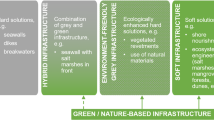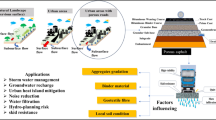Abstract
One of the most significant problems faced by hydraulic engineers is the local scouring of in-stream structures. The optimal design of scour protection methods requires time consuming, laborious and costly studies. Fractional factorial methods have been provided to formulate experimental designs which can optimize designs with fewer experiments and high accuracy. Therefore, this study aimed at using Taguchi and grey relational analysis (GRA) methods to investigate the effect of three factors: (1) spur dike angle, (2) size of riprap stones, and (3) riprap extent on the local scouring. An additional goal was to achieve an economical pattern for the riprap apron so that it delivers the best performance in protecting spur dikes with different angles. The results show that the riprap apron decreases the scouring depth and moves the scouring hole away from around the structure. However, increasing the spur dike angle decreases its performance in scouring reduction. Increasing the area of the riprap apron protected the downstream walls better and reduced the edge failure of the riprap; however, the erosion in the opposite wall increased. In addition, analysis of variance showed that the riprap extent and the spur dike angle, respectively, have the highest effects on the riprap performance, respectively. The comparison of the predictions of the Taguchi and GRA methods with observed values showed that these two methods have high capabilities to predict the results of scouring studies.












Similar content being viewed by others
Abbreviations
- Ar :
-
Area of riprap extent (cm2)
- B:
-
Flume width (cm)
- Cf%:
-
Percentage contribution
- \({\overline{A} }_{m}\), \({\overline{B} }_{m}\) and \({\overline{C} }_{m}\) :
-
Mean of response values for each factor at level m
- Dr50 :
-
Median diameter of stable riprap aggregates (mm)
- d50 :
-
Median diameter of bed particles (mm)
- ds:
-
Maximum scour depth for protected tests (cm)
- dsu :
-
Maximum scour depth for control tests (cm)
- Fr1 :
-
Froude number at the abutment section
- fx :
-
Response variable value in equation 6
- g:
-
Gravitational acceleration (m/s2)
- L:
-
Effective length of spur dike (cm)
- n:
-
Number of response variables
- nIm :
-
number of occurrences of factor I at level m
- Q:
-
Flow discharge (lit/s)
- Rds%:
-
Percentage reduction of maximum scour depth
- RV% :
-
Percentage reduction of scour volume
- T:
-
Sum of response variables
- t:
-
Riprap layer thickness (cm)
- U:
-
Mean velocity of flow (m/s)
- U1 :
-
Mean velocity of flow at the abutment section (m/s)
- Ucr :
-
Particle threshold velocity (m/s)
- u*cr :
-
Critical shear velocity (cm/s)
- Ss:
-
Relative density of the riprap aggregates
- SSF :
-
Sum of squares for the factor F
- SST :
-
Sum of squares of all factors
- Vu :
-
Scour volume for control tests (cm3)
- V:
-
Scour volume for unprotected tests (cm3)
- W:
-
Distance from the tip of the spur dike to the edge of the riprap extent (cm)
- xi(k):
-
Grey Relational Generation (GRN)
- Y:
-
Flow depth (cm)
- θ:
-
Spur dike installation angle
- η:
-
predicted response variable
- ζ:
-
Distinguishing coefficient
- \({\upgamma }_{{\text{0,i}}} \left( {\text{k}} \right)\) :
-
Grey Relational Coefficient (GRC)
- \({\upgamma }_{{\text{0,i}}}\) :
-
Grey Relational Grade (GRG)
References
Karami H, Ardeshir A, Saneie M and Salamatian S A 2012 Prediction of time variation of scour depth around spur dikes using neural networks. J. Hydroinformatics 14: 180–191.
Wang C, Yu X and Liang F 2017 A review of bridge scour: mechanism, estimation, monitoring and countermeasures. Nat. Hazards 87: 1881–1906.
Karami H, Ardeshir A, Behzadian K and Ghodsian M 2011 Protective spur dike for scour mitigation of existing spur dikes. J. Hydraul. Res. 49: 809–813.
Haque M A, Rahman M M, Islam G M T and Hussain M A 2007 Scour mitigation at bridge piers using sacrificial piles. Int. J. Sediment Res. 22: 49–59.
Tafarojnoruz A, Gaudio R and Calomino F 2012 Evaluation of flow-altering countermeasures against bridge pier scour. J. Hydraul. Eng. 138: 297–305.
Atarodi A, Karami H, Hosseini K, Ardeshir A, Hosseini K and Lampert D 2020 Experimental investigation of scour reduction around spur dikes by collar using taguchi method. Iran. J. Sci. Technol. Trans. Civ. Eng. 45: 971–983.
Kayaturk S 2005 Scour and scour protection at bridge abutments. Ph.D Thesis, Middle East Technical University, Ankara, Turkey
Gupta U P, Ojha C S P and Sharma N 2010 Enhancing utility of submerged vanes with collar. J. Hydraul. Eng. 136: 651–655.
Karami H, Hosseinjanzadeh H, Hosseini K and Ardeshir A 2017 Scour and three-dimensional flow field measurement around short vertical-wall abutment protected by collar. J. Civ. Eng. 22: 141–152.
Gisonni C and Hager W H 2008 Spur failure in river engineering. J. Hydraul. Eng. 134: 135–145.
Cardoso A H, Simarro G, Fael C, Le Doucen O and Schleiss A J 2010 Toe protection for spill-through and vertical-wall abutments. J. Hydraul. Res. 48: 491–498.
Melville B W, van Ballegooy S, Coleman S E and Barkdoll B 2007 Riprap size selection at wing-wall abutments. J. Hydraul. Eng. 133: 1265–1269.
Pagan-Ortiz J E 1991 Stability of rock riprap for protection at toe of abutments at flood plain. Transp. Res. Rec. 5: 34–43.
Parker G, Toro-Escobar C and Voigt Jr R L 1998 Countermeasures to protect bridge piers from scour.St. Anthony Falls Laboratory, University of Minnesota, Minneapolis
Hoe D A 2001 Cable-tied block protection of bridge abutments. Proj. Rep. No. PCRE, 118
Chiew Y M 1995 Mechanics of riprap failure at bridge piers. J. Hydraul. Eng. 121: 635–643.
Melville B, van Ballegooy S, Stephen C and Barkdoll B 2006 Countermeasure toe protection at spill-through abutments. J. Hydraul. Eng. 132: 235–245.
Dey S, Chiew Y M and Kadam M S 2008 Local scour and riprap stability at an abutment. J. Hydraul. Eng. 134: 1496–1502.
Cardoso A H and Fael C M S 2009 Protecting vertical-wall abutments with riprap mattresses. J. Hydraul. Eng. 135: 457–465.
Zarrati A R, Chamani M R, Shafaie A and Latifi M 2010 Scour countermeasures for cylindrical piers using riprap and combination of collar and riprap. Int. J. Sediment Res. 25: 313–322.
Lagasse P F, Clopper P E, Pagan-Ortiz J E, Zevenbergen L W, Arneson L A, Schall J D and Girard L G 2009 Bridge scour and stream instability countermeasures: experience, selection, and design guidance-third edition. Hydraul. Eng. Circ. 2: 376.
Lagasse P F, Clooper P E, Pagan-Ortiz, J E, Zevenbergen L W, Arneson L A, Schall J D and Girard L G 2009 Bridge scour and stream instability countermeasures: experience, selection, and design guidance (hec-23)
Hosseinjanzadeh H 2016 Experimental study on the effect of using collar and riprap on flow pattern and scouring at bridge abutments. Semnan University, Semnan.
Roy R K 2010 A primer on the Taguchi method. 2nd edn. Society of Manufacturing Engineers, Dearborn.
Phadke M S 1989 Quality engineering using robust design. Prentice Hall PTR, New Jersey.
Tilak K B G and Nagaraju D 2018 Investigation on aluminium alloy 1100 using taguchi robust design methodology on cnc milling. Mater. Today Proc. 5: 12719–12724.
Aber S, Salari D and Parsa M R 2010 Employing the taguchi method to obtain the optimum conditions of coagulation-flocculation process in tannery wastewater treatment. Chem. Eng. J. 162: 127–134.
Sun B Y, Xiao J B, Li Z B, Ma B, Zhang L T, Huang Y L and Bai L F 2017 An analysis of soil detachment capacity under freeze-thaw conditions using the taguchi method. Catena 162: 100–107.
Ai L, Zhang G, Li W, Liu G and Liu Q 2018 Optimization of radial-type superconducting magnetic bearing using the taguchi method. Phys. C Supercond. its Appl. 550: 57–64.
Song S, Cho H B and Kim H T 2018 Surfactant-free synthesis of high surface area silica nanoparticles derived from rice husks by employing the taguchi approach. J. Ind. Eng. Chem. 61: 281–287.
Katata-Seru L, Lebepe T C, Aremu O S and Bahadur I 2017 Application of taguchi method to optimize garlic essential oil nanoemulsions. J. Mol. Liq. 244: 279–284.
Lin J L and Lin C L 2002 The use of the orthogonal array with grey relational analysis to optimize the electrical discharge machining process with multiple performance characteristics. Int. J. Mach. Tools Manuf. 42: 237–244.
Jeyapaul R, Shahabudeen P and Krishnaiah K 2005 Quality management research by considering multi-response problems in the taguchi method - a review. Int. J. Adv. Manuf. Technol. 26: 1331–1337.
Deng J 1989 Introduction to grey system theory. J. grey Syst. 1: 1–24.
Kuo Y, Yang T and Huang G W 2008 The use of a grey-based taguchi method for optimizing multi-response simulation problems. Eng. Optim. 40: 517–528.
Liu S, Forrest J and Yang Y 2012 A brief introduction to grey systems theory. Grey Syst. Theory Appl. 2: 89–104.
Jeffrey Kuo C F, Su T L, Jhang P R, Huang C Y and Chiu C H 2011 Using the taguchi method and grey relational analysis to optimize the flat-plate collector process with multiple quality characteristics in solar energy collector manufacturing. Energy 36: 3554–3562.
Tarng Y S, Juang S C and Chang C H 2002 The use of grey-based taguchi methods to determine submerged arc welding process parameters in hardfacing. J. Mater. Process. Technol. 128: 1–6.
Chiang Y M and Hsieh H H 2009 The use of the taguchi method with grey relational analysis to optimize the thin-film sputtering process with multiple quality characteristic in color filter manufacturing. Comput. Ind. Eng. 56: 648–661.
Zhang H and Nakagawa H 2008 Scour around spur dyke: recent advances and future researches. Annu. Disas. Prev. Res. Inst. Kyoto Univ. 2: 51633–652.
Dey S, Bose S K and Sastry G L N 1995 Clear water scour at circular piers: a model. J. Hydraul. Eng. 121: 869–876.
Dey S and Barbhuiya A K 2005 Time variation of scour at abutments. J. Hydraul. Eng. 131: 11–23.
Van Rijn L C 1993 Principles of sediment transport in rivers, estuaries and coastal seas. Aqua Publications, Amsterdam.
Unger J and Hager W H 2006 Riprap failure at circular bridge piers. J. Hydraul. Eng. 132: 354–362.
Sadeghi S H, Moosavi V, Karami A and Behnia N 2012 Soil erosion assessment and prioritization of affecting factors at plot scale using the taguchi method. J. Hydrol. 448–449: 174–180.
Author information
Authors and Affiliations
Corresponding author
Rights and permissions
About this article
Cite this article
Atarodi, A., Karami, H., Ardeshir, A. et al. Optimization of the performance of riprap apron to protect spur dikes against scouring using Taguchi and grey relational analysis methods. Sādhanā 48, 18 (2023). https://doi.org/10.1007/s12046-022-02073-0
Received:
Revised:
Accepted:
Published:
DOI: https://doi.org/10.1007/s12046-022-02073-0




